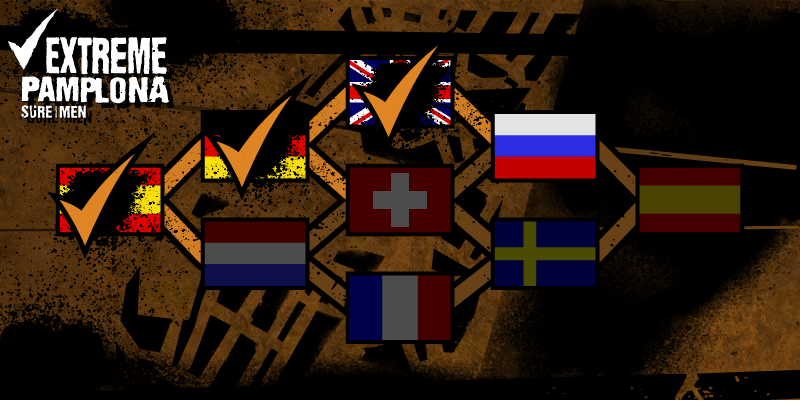

Grammy Hall eyes their Jewish guest with unabashed distaste.

It is Easter dinner, ham is on the menu and antisemitism is never far from the surface. Perceiving himself through the eyes of his upper crust WASP hosts, Alvy Singer (Woody Allen) morphs into a Hasid, sporting a long coat, broad-brimmed hat and payot. An American Tail (1986) – “There Are No Cats in America” Please read, enjoy and, if the spirit moves you, watch. The collection – listed alphabetically but numbered for your convenience – ranges from the silent era to the Safdie Brothers, includes animated mice, Yiddish, Inquisition-themed synchronized swimming and yes, even the Neil Diamond “Jazz Singer” remake.
#Extreme pamplona game online free movie
You will also find essays that take a closer look at Haredi life captured on film, a tour de force takedown of Hitler, what makes movie sets Jewish and more.
#Extreme pamplona game online free archive
The contributors to this list are senior editor Adam Langer (AL), writer and comedian Jess Zeidman (JZ), “The Hebrew Hammer” writer and director Jonathan Kesselman (JK), “Comedy by the Numbers” co-writer Gary Rudoren (GR), author and pop culture historian Dan Epstein (DE), music historian and inaugural director of the YIVO recorded sound archive Henry Sapoznik (HS), film critic Simi Horwitz (SH), staff writer Irene Katz Connelly (IKC), staff reporter Mira Fox (MF), film critic Carrie Rickey (CR), former Forward executive editor Dan Friedman (DF), Forward contributing art critic Jackson Arn (JA) and New York historian and tour guide Andrew Silverstein (AS). To assemble this list, we relied on a panel of experts, including critic Leonard Maltin and film historian Olga Gershenson. Some highlight ritual, others language and still others a worldview or perspective that resonates with the shul-going, shiva-sitting, saw-you-at-Zabar’s set that’s been kicking around since Sinai. This list, which features some surprises, many obvious choices and surely just as many accidental omissions, is an attempt to capture the diversity and scope of Jewish moments in the film canon. If you were to edit the greatest Jewish scenes into a montage, how long would it last? Perhaps not the whole Parsha cycle, but it would be a real commitment to watch the entire thing.

Hearing the words “mazel tov” or “schlep” or seeing a bride and groom lifted aloft on chairs as “Hava Nagila” plays was no longer uncommon at the cinema. Hollywood was Jewish and so, in many instances, was the film scene in Europe, South America and a new state in the Levant called Israel. Otto Preminger would make “Exodus” with Paul Newman. Paul Mazursky and Sidney Lumet would capture the counterculture and document the life of survivors. Filmmakers like Mel Brooks, Mike Nichols, Elaine May and Woody Allen would kick off a renaissance of Jewish humor in the movies, fully committing to what their predecessors only hinted at. But their films weren’t necessarily Jewish – at least not yet.īy the 1960s, studios, once reticent to touch on Jewish topics – out of disinterest, fear of an alienated audience or the threat of German boycott throughout the 1930s – were happy to roll the dice on actors named Dustin Hoffman and Barbra Streisand. With the rise of the Third Reich, Hollywood welcomed a crop of European Jewish talent (directors like Billy Wilder, Otto Preminger and Fritz Lang) whose work would enrich the landscape of American film. While Ben Hecht wrote the original “Scarface,” an Italian gangster flick for Yiddish theater veteran Paul Muni (n é Frederich Meshilem Meier Weisenfreund), Yiddish film thrived in Europe and the U.S. Austrian screenwriter Henrik Galeen, drawing from Jewish mysticism, helped define the horror genre with “Der Golem.” William Wyler got John Barrymore to say “gonif” in “Counsellor at Law” and the Brothers Marx spoke of their plan to “pass over” a Jewish neighborhood in “Cocoanuts.” The first talkie, 1927’s “The Jazz Singer,” followed the son of a cantor and the generational rift between Old World observance and assimilation. Some Jews, both in America and abroad, couldn’t help but slyly insert some Yiddishkeit into their films. In building what Neal Gabler dubbed “An Empire of Their Own,” moguls recognized the bulk of their audience was Christian, and picked their projects accordingly.īut there were always exceptions that proved the rule. The major stars of the silent and pre-code era typically weren’t of Hebrew stock and, if they were, pretty reliably changed their names along with Jewish directors. And yet, while Jews had an outsized role in shaping Hollywood, Jewish content wasn’t always visible onscreen. This isn’t really saying much, as the medium of film is millennia newer than the People of the Book. For as long as there have been moving pictures, there have been Jews.


 0 kommentar(er)
0 kommentar(er)
